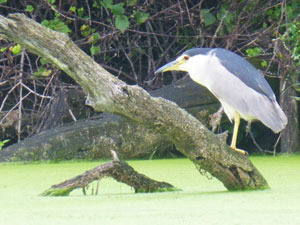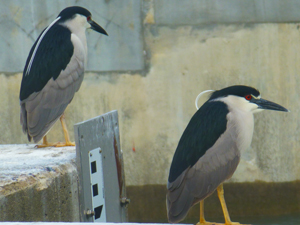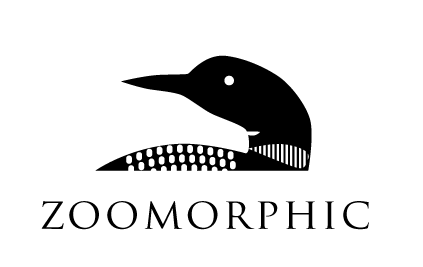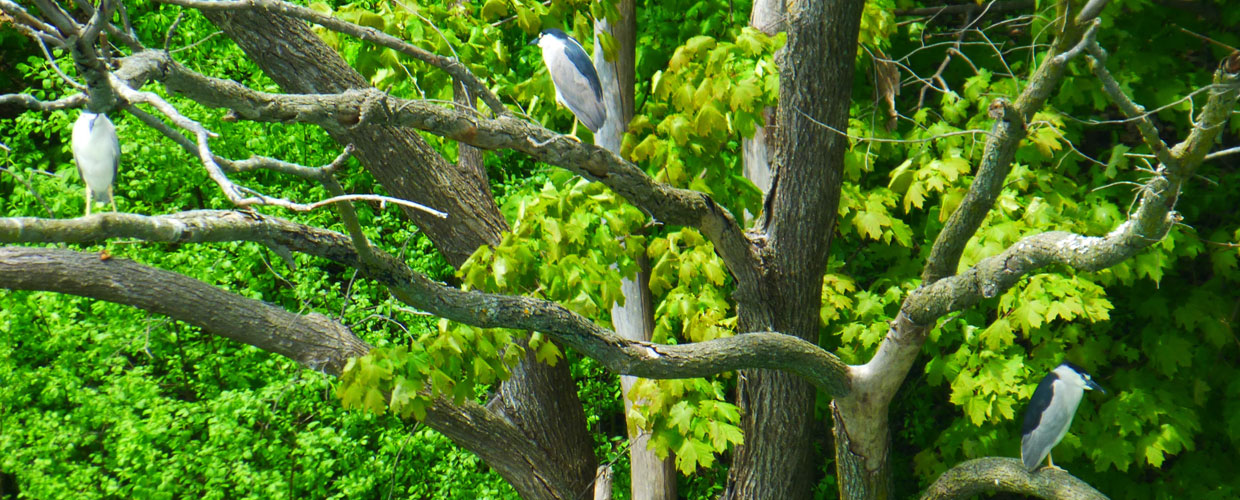by Gavin Van Horn
Ever since I moved to Chicago, I’ve been pondering the question of whether there is a single animal that best captures the essence of this city. Can an animal incarnate a place? On the one hand, I realize my quest is quixotic. I’m tilting at windmills of my own imagination. Which animal best symbolizes a place is one of the more subjective questions a person could ask, and if one were to take it seriously, the answer is open to a thousand viable candidates.
Setting aside the obvious athletic associations of animals with Chicago—da Bears, da Bulls—which are prioritized, as most team logos are, on the fierceness not the residency of the animal, what might be some qualifications for an urban icon? What suite of qualities lends an animal this status? A certain presence in the way that she carries herself, an unquantifiable mystery that induces awe in the beholder that such a creature should share the same space with us? A rarity that makes sighting him a special event, a reason to run home and write down the date and place of discovery or breathlessly recount the story to others? A charismatic physiology or coloration or set of behaviors that we find particularly beautiful, that pours fresh fuel on the fires of our imaginations?
These questions push beyond “favorites” toward something more ethereal, to the animals we feel especially drawn to without knowing precisely why. Wildlife ecologist Aldo Leopold circled such questions and landed on a term for what he was after, numenon.
It is unimportant, unless you derive enjoyment from digging into historical cabinets of curiosities, to know that Leopold borrowed the concept, and the ideas it represented from the Russian philosopher-mystic Pyotor Ouspensky, who, for his part, took it from the turn-of-the-nineteenth-century philosopher Immanuel Kant.* The important thing is that Leopold needed a word to describe a feeling that went beyond physical appearances. Sometimes we feel things so deeply we grope to see if there is a color for the crayon. Germans seem to have a special talent for word combinations that distill what would otherwise demand whole sentences of explanation—Schadenfreude, pleasure derived from the misfortune of others, or Kummerspeck, which literally means “grief bacon” and refers to the excess weight gained from emotional over-eating.
Had Leopold lived to see the creation of the field of conservation biology, he might have opted for flagship, or umbrella, or focal species as his metaphor of choice for what he was after. But maybe not. Those terms somehow seem too ordinary to be useful. He was chasing something closer to the marrow, something that joined marrow, passed clean through it and bound it together.
He was after something, dare I say, spiritual—the numinous spirit of place. Yet he grounded this mysterious spirit of place in a nonhuman animal. Each landscape has a numenon, he writes in the essay “Chihuahua and Sonora,” from his environmental classic A Sand County Almanac. He proposes that the blue jay is the numenon of the hickory groves; the whisky-jack serves this role in the muskegs; the piñonero (piñon jay) for the juniper foothills. “Ornithological texts do not record these facts,” he adds with a wink.
For the north woods, it is the ruffed grouse. About this numinous being, Leopold comments:
In terms of conventional physics, the grouse represents only a millionth of either the mass or the energy of an acre. Yet subtract the grouse and the whole thing is dead. An enormous amount of some kind of motive power has been lost. A philosopher has called this imponderable essence the numenon of material things. It stands in contradiction to phenomenon, which is ponderable and predictable, even to the tossings and turnings of the remotest star.
It is as though a landscape gathers all its energy and concentrates its “imponderable essence” into a species that represents its will and desire to be.
The bulk of Leopold’s short essay is about the numenon of the Sierra Madre in northern Mexico, the thick-billed parrot—a flashy, chatty, communal bird that boldly makes its presence known on the landscape by raising the dawn and scolding unfamiliar visitors. The thick-billed parrot, for Leopold, best incarnated the other-than-human forces that constituted the landscape’s unique presence. The parrot—or the grouse, or the jay—is the visible manifestation of what defines a place qua place, something that, if we are receptive to it, draws us into a greater mystery and fastens us together.
Can a city, a landscape defined by human presence, have numenon? Can one even ask that question of a largely artifactual habitat? I don’t know how Leopold would answer. But I can imagine that if he were here, expansive thinker that he was, he would indulge me. He was, after all, a person who consistently advocated—in the classroom, in the field, and in his writings—for the development of ecological perception. He cautioned that a PhD wasn’t necessary for this mental faculty; in fact, an advanced degree might prove a liability, because “the Ph.D. may become as callous as an undertaker to the mysteries at which he officiates.” For the person skilled with ecological perception, however, “The weeds in a city lot convey the same lesson as the redwoods; the farmer may see in his cow-pasture what may not be vouchsafed to the scientist adventuring in the South Seas.” The intricate connections between plants and animals, through time and across landscapes, are available to us all, no matter where we are. Even weeds in a city lot can open a portal to interconnected fantasias.
The city is characterized by the deep imprint of human activity, but it is not dead matter. It is not an iron lung, breathing by mechanical pumps and pistons. Woven into its living fabric are the lives of legions. I think Leopold would argue a little ecological perception can go a long way, even in the city.
So what animal might best embody the numenon of Chicago?
Coyotes? Make no mistake, I identify with coyotes on a personal level. They are the quintessential urban adapters. Any-habitat-adapters might be putting it more accurately. They continue to surprise and trickify as the comeback kids. But there’s a catch. They’ve been able to do so successfully because we’re missing wolves in Illinois, have been for 150 years, the species that would have hampered the coyote’s dramatic success or suppressed their outmigration from the West altogether. The numenon of Chicago must be, how to say it, more autochthonous, a long-term resident.
Peregrine falcons? Another comeback kid, a triumphant story of reestablishing their presence after a precipitous decline due to human poisons. Also a feel-good symbol of humans awakening to destructive actions and lending a hand in the recovery process. Other attributes—built for speed, terrifying in their power, graceful in their precision, stoic in their demeanor. Peregrines have made the city theirs, as though they orchestrated the construction of skyscrapers, using us as pawns to raise the flattened Midwest to suit their elevated purpose. Chicago is one city among many that peregrines have reclaimed, though their geographical promiscuity doesn’t make them approachable. They live out of reach and often out of sight. Unless you have climbing gear and a hard hat, they are a difficult bird to observe. They embody the ethereal qualities of the numenon, but though they are in they city they are not quite of the city.
If not coyotes, “the ghosts of Chicago,” or peregrines, the winged dynamo, then whom? I’d like to make an argument on behalf of what might seem, at first blush, an unlikely candidate. A creature with a name that sounds like the sobriquet of a comic book anti-hero: the Black-crowned Night Heron.
 This is a bird of contrasts and juxtapositions. The species takes its name from the cap, or crown, of black that divides the heron’s head into a sideways yin-yang, but the first feature you may notice is the pair of ivory colored feathers projecting like white contrails from the base of that head. Or the midnight blue contrast of his back, offset by the downy white of his underbelly. Maybe the pair of corncob yellow legs that prop up his football-shaped body and hold it still, as though it’s on a tee.
This is a bird of contrasts and juxtapositions. The species takes its name from the cap, or crown, of black that divides the heron’s head into a sideways yin-yang, but the first feature you may notice is the pair of ivory colored feathers projecting like white contrails from the base of that head. Or the midnight blue contrast of his back, offset by the downy white of his underbelly. Maybe the pair of corncob yellow legs that prop up his football-shaped body and hold it still, as though it’s on a tee.
But eventually the heron’s red eye, a ruby supernova that deepens to a blackhole center, will pull you in. This red eye fixes you in its gaze, letting you know that you are part of his passing world, not he of yours. Black-crowned will do, its evocative as species names go, but better would be the Red-eyed Night Heron.
By land, they don’t usually allow me close. But if I’m in their watery domains, I can, with appropriate gentleness, paddle near enough that the cool red marble locks onto me.
We don’t have much by way of rivers in the section of the city in which I live. We have to make due with a manmade canal, the North Shore Channel, which was cut in the early twentieth century to facilitate the removal of human waste. Down the canal; out of sight, out of mind. With modern treatment systems, conditions have improved for the channel waters, enough that travelling on top of the water is deemed safe. Squint your eyes and it feels like an honest to goodness creek. At least the herons think so.
In recent years, I’ve seen them on the Channel with increasing frequency. They aren’t nesting there, but the waterway makes a decent hunting ground. They seem to like the portion closest to the lake best. One day, I saw no less than eleven of them perched above the waters, some in trees, some on a cement wall, eyeballing the waters below, meditating on fish.
I felt privileged to bear witness. Night herons are a state endangered bird. They once lived on the far Southeast Side of Chicago in some scrappy pocket wetlands, surviving between steel factories and car assembly plants. Then, around 2009, they moved. They moved toward downtown Chicago. They moved to the zoo.
Location, location, location. Walking distance from Lake Michigan and two-and-a-half miles north of the Loop, Lincoln Park Zoo has nine hundred resident species and serves as “Chicago’s Living Classroom.” It’s also a free-to-the-public zoo, which may account for the more than 3.5 million visitors who come each year. In 2008, the zoo constructed a “Nature Boardwalk,” deepening an already existing pond that lies just outside the entrance, planting native vegetation, and introducing aquatic organisms. There’s a walking path that loops around and away from the fourteen-acre area, a popular spot for strolling and snapping pictures, and now, getting splattered with night heron poo.
You see, the night herons—there were 300 nesting pairs in 2015—have selected two locations for their nesting colonies that overhang pedestrian walkways. One is located by the Lincoln Memorial statue just south of the Nature Boardwalk; the other is located over the red wolf exhibit in the zoo itself. No one said that nests or nest location were night heron specialities. Unlike the beautiful tight weave of a warbler’s home or the mud-dappled engineering of a cliff swallow’s abode, night heron nests look like afterthought. Their nests prioritize function over form, little more than a jumble of medium-size sticks jammed into the crook of a tree.
exhibit in the zoo itself. No one said that nests or nest location were night heron specialities. Unlike the beautiful tight weave of a warbler’s home or the mud-dappled engineering of a cliff swallow’s abode, night heron nests look like afterthought. Their nests prioritize function over form, little more than a jumble of medium-size sticks jammed into the crook of a tree.
Whatever works. And, apparently, they will build these brushpiles wherever they damn well please. Even over heavily trafficked footpaths in the heart of Chicago. Which returns me to subject of heron poo. In my estimation, any bird that intentionally or unintentionally puts us in our place, causes us to take note of its presence, reminds us that we are subject to more-than-human forces by tarnishing our self-importance as well as our button-down shirts, has my respect. Let us call this the virtue of night heron shit.
But the Black-crown Night Heron’s construction abilities belie the bird’s physical elegance and energetic concision. They are meditators, as I said. The body does not often stir, and when it does, it is for the purpose of mindful stalking. One yellow leg, slowly raised, purposefully placed, the heron makes his food expend energy finding him. Then, like a lightning flash, he strikes.
Their nests, their bodies, and their behaviors evoke a certain prehistoric deep time that contrasts with their modern choices of city habitat. They represent the wild forces, bent but unbroken, that pulse through the city. All these are good reasons for numenal consideration. But, for me, it is the eye that distinguishes the Black-crowned Night Heron’s claim as numenon of Chicago. We need to be eyed with a bit of suspicion. Our approach should be cause for other animals’ concern. We have not gently claimed the city; we steamrolled our way into the landscape, cut channels to flush our unwanted pollutions away from us (and toward someone else), tore through prairie to build shopping malls, and threw concrete wherever we pleased.
And yet.
The herons are part of our story, and we theirs, entangled in a city of juxtapositions that rub against one another, like the black and white of a heron’s head. A man-made canal that can’t be safely swum, but has been repurposed by avian and aquatic beings for food, shelter, and safe passage. A zoo in one of the more densely populated portions of the city that hosts their nesting colonies. An endangered bird who finds the city homey. The Black-crowned Night Heron carries the juxtapositions of the landscape in his body, reclaiming the fruits of modern engineering with a pre-modern disposition. He is the numenon, the will and self-expression of the land, the mysterious essence of this place. The bird bears these entangled histories, and we with him, into an unknown future.
All the while, the cool red marble warily watches. There are cool red eyes watching us all, wondering if these humans will find a way to adapt to this place, to inhabit a city in a way that is enduring. Red eyes waiting. Red eyes watching.
* If you are an appreciator of Western philosophy and its modern-day interpretations, or a glutton for academic excavation, Ashley Pryor offers an astute and engaging tour of the relationship between Leopold’s and Ouspensky’s writing, especially their shared interest in a impersonal nature mysticism in her article “Thinking like a Mystic: The Legacy of P.D. Ouspenksy’s Tertium Organum on the Development of Aldo Leopold’s ‘Thinking Like a Mountain,’” Journal for the Study of Religion, Nature and Culture 5, no. 4 (2011): 465-490.
Gavin Van Horn is the Director of Cultures of Conservation for the Center for Humans and Nature. He is the co-editor of City Creatures: Animal Encounters in the Chicago Wilderness (University of Chicago Press, 2015) and Relative Wild: Common Grounds for Conservation (University of Chicago Press, in progress). He writes for, edits, and curates the City Creatures blog.
All images by Gavin Van Horn

